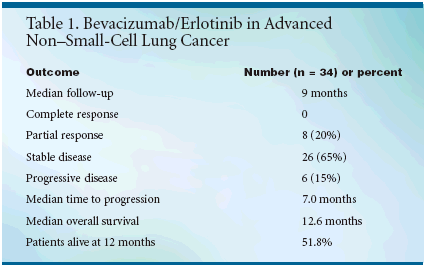Bevacizumab/Erlotinib Moves on to Phase II Randomized Trial Among Patients With Advanced NSCLC
This supplement to Oncology News International includes 17 reportson clinical trials of targeted therapies used alone, in combination with chemotherapy,or in combination with each other in the treatment of non–small-cell lung cancer (NSCLC),bronchoalveolar carcinoma, glioblastoma multiforme, and renal cell carcinoma.Included is a report on a novel targeted agent recently approved for treatment of NSCLC.
NASHVILLE, Tennessee-Promising outcomes in a phase I/IItrial of the bevacizumab (Avastin)and erlotinib (Tarceva) combinationagainst recurrent non-small-cell lungcancer (NSCLC) have prompted aphase II study testing bevacizumab/erlotinib against bevacizumab/docetaxel(Taxotere) and docetaxel/placebo.Alan B. Sandler, MD, of VanderbiltUniversity Medical Center,Nashville, Tennessee, described theresults of the phase I/II bevacizumab/erlotinib study (abstract 2000).The rationale for combining bevacizumab,a vascular endothelial growthfactor blocker, and erlotinib, anHER1/epithelial growth factor receptortyrosine kinase blocker, is groundedin preclinical work showing synergyfor these two targeted agents usedtogether in mice with human tumorxenografts, Dr. Sandler explained.Dosing and ToxicitiesThe primary objective of the phaseI/II study was to establish the maximumtolerated doses of the combinationand to examine dose-limiting toxicities.The secondary objective was toevaluate the pharmacokinetics for potentialdrug interactions.The phase I/II trial enrolled 40 patients(21 female, 19 male) with recurrent,nonsquamous, stage IIIB (withpleural effusion), stage IV, or recur-rent NSCLC. All had received at leastone prior chemotherapy regimen.Thirty (75%) had adenocarcinomas,one (5%) had bronchoalveolar carcinoma(BAC), and nine (22.5%) hadNSCLC not otherwise specified. Medianage was 59 (range 36-72).The phase I part of the study wastoxicity analysis in the first 12 patients.The main toxicities reportedwere mild rash, diarrhea, and proteinuria.There were no hemorrhagesin any of these patients. The highestdose tested in this phase I part of thestudy, erlotinib 150 mg/d po plus bevacizumab 15 mg/kg IV every 21 days,was selected as the phase II dose, althoughno true dose-limiting toxicitieswere seen. There were also no pharmacokineticindications of druginteractions. Among the 12 patientstreated in the phase I segment were 4with partial responses (PR) and 6 withstable disease (SD).

These promising outcomes encouragedthe investigators to press on withbethephase II part of the study. Amongthe 34 patients in this phase were 1patient with grade 4 pulmonarytoxicity that is still under investigation,2 patients (6%) with grade 3hypertension, and 1 with grade 3vomiting.The phase II treatment produced20% PR and 65% SD, for a clinicalcontrol rate of 85%. Median time toprogression was 7.0 months (see Table1). Dr. Sandler said that response wasquite durable in many patients, includingone patient who has continuedon treatment without progressionfor almost 2 years."The response rate was 20% andmedian survival was 12.6 months, butit is important to remember that ahigh number of patients had adenocarcinomas,and patients with brainmetastases were excluded," he said.Dr. Sandler reported that a randomizedphase II trial was expectedto begin in summer 2004 and wouldseek to enroll about 200 patients.